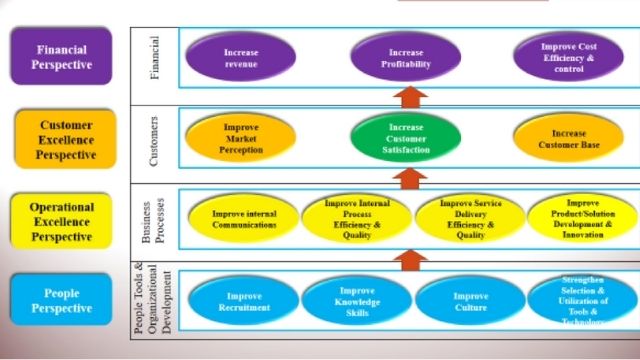Effective strategic management through deployment of lean six sigma with balanced scorecard

Leadership & Management
245 week ago — 6 min read
In today’s VUCA (Volatile, Uncertain, Complex and Ambiguous) business environment, maintaining the competitive edge is a challenge for many organisations. Unlike the approach of basing strategic planning mainly on historical data, organisations need to adopt a more proactive path.
A Balanced scorecard is a modern approach to strategic management that aligns the organisation’s activities to achieve its long term objectives. It measures long-term performance in terms of 4 perspectives:
- People perspective (learning & growth)
- Business process & innovation perspective
- Customer satisfaction perspective
- Finance perspective.

It is called as balanced scorecard because it helps the management to focus on all the 4 perspectives leading to more proactive strategic management. Using a balanced scorecard and lean six sigma together can be seen as an “ultimate” management solution. Balance scorecard can be used to identify the processes that are important and lean six sigma can be used to improve those processes.
Lean six sigma initiatives were first started as a powerful process improvement tool at Motorola in 1986 and gradually became the most popular process-excellence tool due to its organisation-wide implementation by Jack Welch (GE Group) from 1995. Today nearly 60% of the Fortune-500 companies, worldwide, use lean six sigma methodologies to achieve process excellence.
Lean six sigma is a disciplined, data-driven methodology that uses the strength of cross-functional teams to eliminate defects and reduce variations, in any process - from manufacturing to transactional and from product to service. To reach six sigma level of performance, a process must not produce more than 3.4 defects per million transactions.
A balanced scorecard is a framework for integrating performance measures defined by Robert Kaplan and David Norton in 1990s. Many organisations today are implementing balanced scorecard as their strategic management plan. The four perspectives of balanced scorecard proposed by Kaplan and Norton, as listed above, provide a framework to describe the strategy for creating value and tools to manage the execution of that strategy. Balance scorecard helps us to identify performance gaps and is used to facilitate decisions on how to address specific performance issues. However, unlike lean six sigma, the balanced scorecard is not a solution for closing specific strategic performance shortfalls.
Balanced scorecard and lean six sigma become complementary because ‘balanced scorecard’ provides the strategic context for targeted improvement initiatives and ‘lean six sigma’ is a business improvement methodology that can solve hundreds of performance issues.
As an example, consider an organisation that wants to increase sales turnover by 80% over the next 5 years. The strategy for doing this requires:
- Increase in number of products,
- Increase in the number of customers,
- Increase in repeat business.
How will these be measured?
1. Increase in the number of products can be measured in terms of revenue from new products. Based on this measurement, targets and action plans for the launch of new products during the next 5 years can be established.
2.Increase in the number of customers can be measured in terms of revenue from new customers. Based on this measurement, targets and action plans for finding potential customers, and markets, during the next 5 years can be defined.
3.Increase in repeat business can be measured in terms of revenues from repeat customers. Based on this measurement, targets and action plans for retention of existing customers can be established.
In all these cases the analytical and cross-functional brain-storming tools of lean six sigma can be used to overcome road-blocks related to increasing the number of products, increasing the number of customers and achieving higher levels of customer retention. Increasing the number of products would require cross-functional collaboration between the marketing, design and production functions to achieve holistic product development as per the established targets. Similarly, increasing retention of customers would require data analysis to identify the reasons for lost customers, the cross-functional collaboration between the customer service, marketing & production functions and training people to improve their people-management skills.
In short, balanced scorecard defines the strategy for creating value and planning the resources required for the successful execution of strategy. On the other hand, lean six sigma tools are used to implement the strategies by using a variety of analytical and process improvement tools to achieve long-term targets as per the planned measurements.
Also read: How to make successful business decisions using Cartesian Coordinates
To explore business opportunities, link with me by clicking on the 'Connect' button on my eBiz Card.
Image source: shutterstock.com
Disclaimer: The views and opinions expressed in this article are those of the author and do not necessarily reflect the views, official policy or position of GlobalLinker.
Posted by
Gk K SinghWe offer training & Consultancy for Six Sigma, Lean & Analytics implementation improving organization's top-line and bottom-line
View Gk 's profile
Most read this week
Trending
Ecommerce 13 week ago









Comments
Share this content
Please login or Register to join the discussion